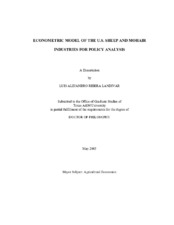| dc.description.abstract | The U.S. sheep industry has been declining in size for many years. Many factors have contributed to the decline of the sheep industry including declining consumption of lamb and mutton, the growth in manmade fiber use, scarcity of labor, and predator losses.
In an effort to slow the rate of decline in the U.S. sheep industry, the U.S. Congress passed the Wool Act of 1954. In 1993, Congress passed a three-year phase out of the Wool Act incentive payments with the last payments occurring in 1996. The 2002 Farm Bill included a marketing loan program for wool. The loan rates are set to $0.40 per pound for un-graded wool, $1.00 per pound for graded wool. In recent years exchange rate changes have had a large impact on the industry affecting lamb and wool trade.
The U.S. is the second largest producer of mohair and Texas accounts for over 85 percent of the U.S. mohair production. Mohair also received incentive payments through the Wool Act. Mohair payments were also phased out along with the wool incentive payments. Moreover, the 2002 Farm Bill reinstated support for the industry by implementing a loan program with loan rates of $4.20 per pound of mohair.
This analysis uses capital stock inventory accounting methodology to model the supply side of the sheep industry. Demand is incorporated using traditional single equations and complete demand system estimation methods. OLS, 2SLS, and 3SLS models are developed and tested for the single equations estimation methods. The OLS model is used to model the impacts of three different levels of loan rates for wool. Also, an OLS mohair model is developed and used to examine the impacts of three different levels of loan rates for mohair. Results indicate that the sheep industry will continue to decline even with the marketing loan program for wool in the 2002 Farm Bill. However, a higher loan rate for wool would reduce the decline rate of the industry. The Angora goat industry will continue to decline in size, but with a higher loan rate for mohair, the number of goats clipped would increase. | en |


